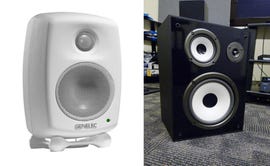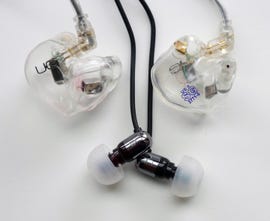I’m an audiophile who loves music and audio gear more or less equally. That said, I think anyone who from time to time really savors music is an audiophile, or might become one at a future date. To clear the air a bit for up an coming audiophiles, I’m going to bust a few audiophile myths. Here we go.
Three-way speakers always sound better than two-way speakers.
No way! Two-way speakers have a woofer and a tweeter; three-way speakers have a woofer, midrange, and a tweeter, but do more drivers guarantee better sound quality? While in theory adding a midrange driver should improve the sound, it’s the quality, not quantity of the drivers, and the rest of the speaker design that determines the overall sound quality. So sure, a three-way speaker might sound better than a two-way, but the number of drivers in no way assures superior performance.

 Enlarge Image
Enlarge ImageThe two-way speaker on the left sounds way better than the three-way speaker on the right.
Steve Guttenberg/CNET
Multichannel home theaters sound better than stereo home theaters.
Movies may be mixed primarily for multichannel sound, but the film’s producers also know the vast majority of home viewers will be listening through the stereo speakers built into their TVs or sound bars, so they make sure the movie’s soundtrack sounds fine in stereo. I’m in no way recommending listening to your TV’s speakers, but I’ve had terrific results with decent stereo speakers, starting with the budget-priced Pioneer SP-BS22-LR and ELAC Debut B6, up through KEF LS50, Zu Druid V, and Magnepan 3.7i flat panel speakers.
Not every room is big enough or all that suitable for five or more speakers, so a great sounding set of stereo speakers is a worthy alternative.

 Enlarge Image
Enlarge ImageThe custom-molded in-ear headphones (top), are considerably less comfy than the universal fit in-ears (bottom).
Steve Guttenberg/CNET
Custom-molded in-ear headphones are more comfortable than universal fit headphones.
Untrue! “Custom fitted,” aka molded to your ear canals, headphones do provide superior isolation from external noise and a more secure fit than universal fit in-ear headphones, but I don’t find customs particularly comfortable. I’m not saying they’re uncomfortable, but having big plastic things in my ears is hardly ideal. Smaller in-ears are more comfortable than larger and heavier ones.
Analog sounds better than digital (or digital sounds better than analog).
They’re different. If digital were truly better it would have killed the LP and analog tape recording decades ago, but LP sales go up year after year. Digital is more convenient, and can be played anywhere, it’s easier to record, mix, and master. I might even concede that the best digital audio is more accurate, but to many audiophiles, including me, well recorded LPs, played on a decent turntable sound more like real music than the best digital. The analog versus digital stalwarts on each side aren’t backing down, so the battle rages on.
Dynamically compressed music sounds bad.
Dynamic compression isn’t new, it’s been an integral part of recorded and live music for many decades, even in the all-analog, pre-digital days. Compression flattens the music’s dynamic range, so a whisper is as loud as a scream. Completely uncompressed music would sound lifeless and boring to most listeners, that’s why it’s compressed. Audiophiles like to complain about compressed music, but they actually prefer it.
If you have a favorite audiophile myth, share yours in the Comments section below.




